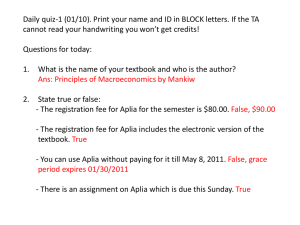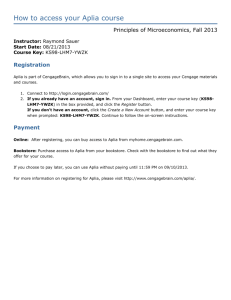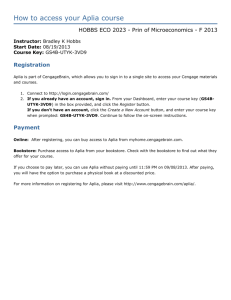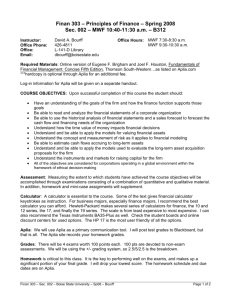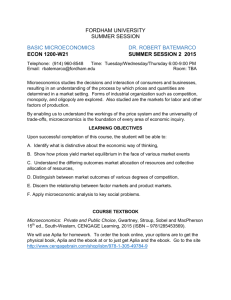Other - Villanova University
advertisement
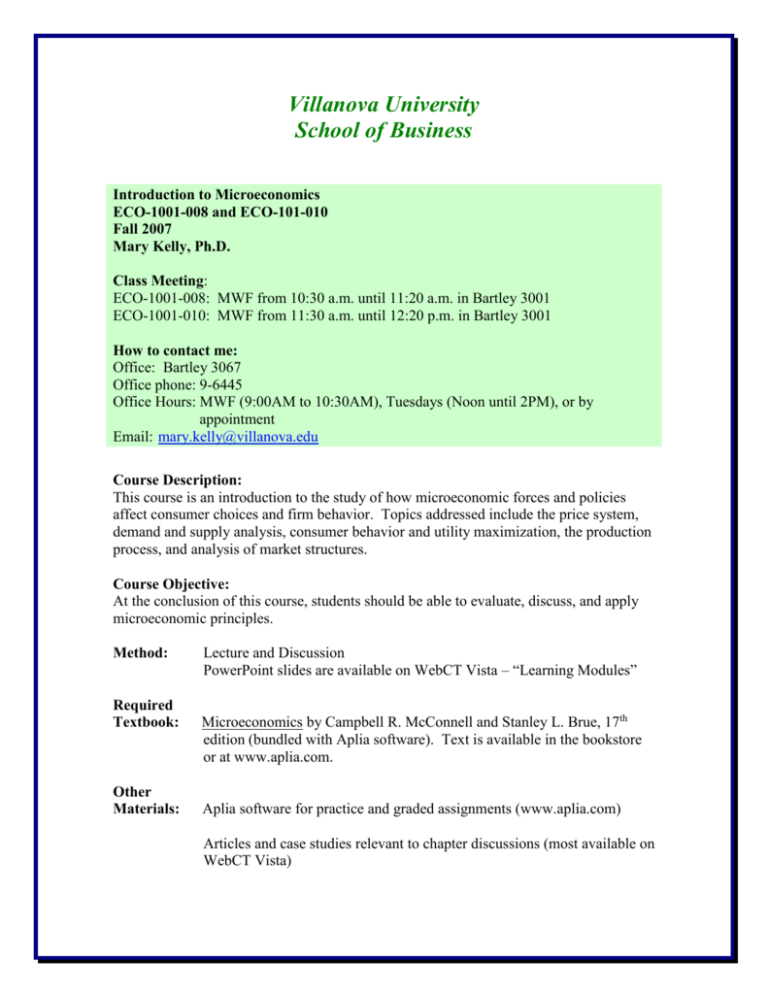
Villanova University School of Business Introduction to Microeconomics ECO-1001-008 and ECO-101-010 Fall 2007 Mary Kelly, Ph.D. Class Meeting: ECO-1001-008: MWF from 10:30 a.m. until 11:20 a.m. in Bartley 3001 ECO-1001-010: MWF from 11:30 a.m. until 12:20 p.m. in Bartley 3001 How to contact me: Office: Bartley 3067 Office phone: 9-6445 Office Hours: MWF (9:00AM to 10:30AM), Tuesdays (Noon until 2PM), or by appointment Email: mary.kelly@villanova.edu Course Description: This course is an introduction to the study of how microeconomic forces and policies affect consumer choices and firm behavior. Topics addressed include the price system, demand and supply analysis, consumer behavior and utility maximization, the production process, and analysis of market structures. Course Objective: At the conclusion of this course, students should be able to evaluate, discuss, and apply microeconomic principles. Method: Required Textbook: Other Materials: Lecture and Discussion PowerPoint slides are available on WebCT Vista – “Learning Modules” Microeconomics by Campbell R. McConnell and Stanley L. Brue, 17th edition (bundled with Aplia software). Text is available in the bookstore or at www.aplia.com. Aplia software for practice and graded assignments (www.aplia.com) Articles and case studies relevant to chapter discussions (most available on WebCT Vista) The Wall Street Journal is available for free throughout Bartley Hall. All other material will be distributed in class or made available on WebCT Vista. Requirements: Exam I Exam II Exam III Assignments Aplia Problem Sets Worksheet/Case Study Analyses Group Project Grading: Points 40 40 40 Chapters 1-4, 6, 7 8-11 13, 14, 16, 18, 20 And presentation topics 20 30 30 Total 200 100-94 (188+ points) 90-93 (180-186 points) 87-89 (174-178 points) 84-86 (168-172 points) 80-83 (160-166 points) 77-79 (154-158 points) A AB+ B BC+ 74-76 (148-152 points) 70-73 (140-146 points ) 67-69 (134-138 points) 64-66 (128-132 points) 60-63 (120-126 points) Below 60 (120- points) C CD+ D DF Grading is determined based on the above criteria. There is no extra credit offered in this course. Rounding up or down will be based on attendance and class participation. Exams: Exams must be taken on the scheduled dates. Make-up exams will be offered only for extenuating circumstances and must be taken within two days of the scheduled exam date. If a student does not take exam I or exam II, the weight on the third exam will increase to 80 points and will include material from the missed exam. Assignments: Worksheet/Case Study Analysis: During the semester, students will be required to complete eight worksheets which will involve an analysis of a case study, external readings associated with particular chapters, or web-based questions from the text. Students can choose to work on these assignments individually or in groups (hand in one assignment per group, max of 4 students/group). Some of the assignments will be take-home; others will be completed in class. Aplia Problem Sets: During the semester, students will be required to complete problems accessed through Aplia to demonstrate their understanding of the chapter material. Due dates for the assignments will be announced in class and will be posted on Aplia. Once the due date passes, the answers are made available to students. Because of this, deadlines cannot be extended on an individual student basis. Group Project Listed below are microeconomic topics. 1. 2. 3. 4. 5. 6. 7. 8. Evaluation of Executive Compensation Packages (chapter 14) Unionism in the U.S. and around the world (chapter 14) U.S. Environmental Laws (Clean Air/Clean Water) (chapter 16) Global Warming and the Kyoto Protocol (chapter 16) Microsoft Antitrust Case (chapter 18) U.S. Health Care Policies and Issues (Medicare and Medicaid) (chapter 20) U.S. Public Pension System (Social Security) Policies and Issues (chapter 20) Income Inequality in the U.S. and around the world (chapter 20) In groups of five to six, students will conduct an in-depth analysis of one of these subtopics in microeconomics. Students will provide a 10 to 15 minute summary of their findings to the class and pose a question for class discussion. The presentation/discussion will be linked to the appropriate chapter. Each group is required to hand in the summary and a bibliography listing information sources. Class Participation: Students are required to attend all lectures and actively participate in the class discussion. You should be prepared for class. This includes reading the chapter and any corresponding material from assigned readings prior to coming to class. Students who do poorly in microeconomics are typically those who have not kept up with the reading. Integrity Policy: The Code of Academic Integrity of Villanova University addresses cheating, fabrication of submitted work, plagiarism, handing in work completed for another course without instructor’s approval, and other forms of dishonesty. For the first offense, a student who violates the Code of Villanova University will receive 0 points for the assignment. The violation will be reported by the instructor to the Dean’s Office and recorded in the student’s file. In addition, the student will be expected to complete an educational program. For the second offense, the student will be dismissed from the University and the reason noted on the student’s official transcript. Disability Statement: It is the policy of Villanova to make reasonable academic accommodations for qualified individuals with disabilities. If you are a person with a disability, please contact me after class or during office hours and make arrangements to register with the Learning Support Office by contacting 610-519-5636 or as soon as possible. Registration is needed in order to receive accommodations. Course Outline: Weeks 1-3 Review of syllabus, WebCT, Aplia Chapters 1 Limits, Alternatives, and Choices Economics is a social science which examines how society fills economic wants using limited resources. Chapter 1 presents how and why we study economics, including a discussion on the economizing problem and the production possibilities model. The appendix of chapter 1 provides a review of graphs and their meaning. Aplia Problem Set #1: Limits, Alternatives, and Choices II Chapter 2 The Market System and the Circular Flow This chapter contrasts different economic systems and specifically addresses the characteristics of a market system. The chapter also answers such questions as what will be produced, how it will be produced, who will get the product, and how the market system will accommodate change. Chapter 3 Demand, Supply, and Market Equilibrium In individual markets, buyers and sellers interact and determine the equilibrium price and quantity for a product or service. Chapter 3 discusses the law of demand and supply and shows how equilibrium is determined. The chapter concludes with an explanation of non-price determinants which change the equilibrium price and/or quantity. Outside reading: Stephen P.A. Brown and Richard Alm. Running on Empty? How Economic Freedom Affects Oil Supplies. Economic Letter, Federal Reserve Bank of Dallas, 1(4). (April 2006). Worksheet Analysis #1: Respond to questions on the above reading (3 pts) Aplia Problem Set #2: Demand & Supply and Market Equilibrium II Weeks 4-5 Chapter 4 The US Economy: Private and Public Sectors There are two major sectors within the market system; the private sector consisting of households and businesses, and the public sector (government). This chapter discusses each sector and uses the Circular Flow Model to demonstrate the interplay between the sectors. Chapter 6 Extension of Demand and Supply Analysis This chapter explores the sensitivity of demand to own price changes, price changes of related products, and income changes. It also shows the differences in supply responses between the short run and long run. Worksheet Analysis #2: An evaluation of cigarette elasticities (3 pts) Aplia Problem Set #3: Extension of Demand and Supply Analysis II Chapter 7 Consumer Behavior and Utility Maximization In the Theory of Consumer Behavior, individuals want to maximize utility when making choices given a particular budget constraint. The appendix provides a more in-depth analysis of consumer behavior using indifference curves. Worksheet Analysis #3: Here is $500 – Go Spend It at Wal-Mart (WB#2, page 137) (3 pts) Aplia Problem Set #4: Consumer Behavior & Utility Maximization II Exam I Weeks 6-7 Chapters 1-4, 6, 7 Wednesday, September 26 Chapter 8 The Costs of Production In order to produce g/s, a business needs economic resources. The firm’s cost of production consists of payments to resource owners and the opportunity costs of using their own resources. Aplia Problem Set #5: The Costs of Production II Chapter 9 Pure Competition This chapter discusses the characteristics and profit maximization in the short-run and long-run of a competitive market structure wherein each firm provide only a very small portion of the total market output. Aplia Problem Set #6: Pure Competition II Week 8 Fall Break Weeks 9-11 Chapter 10 Pure Monopoly This chapter explores the characteristics and profit maximization of a pure monopoly wherein a sole producer supplies the entire market output. Aplia Problem Set #7: Pure Monopoly II Chapter 11 Monopolistic Competition and Oligopoly Most markets fall between the two extremes of pure competition and pure monopoly. This chapter describes the two market types in the middle, including their characteristics, profit maximization, and efficiency outcomes. Outside Reading: Lawrence J. White. Application of the Merger Guidelines: The Proposed Merger of Coca Cola and Dr. Pepper (1986). The Antitrust Bulletin. Edited by John Kwoka, Jr. and Lawrence J. White. Oxford University Press, 2002. http://www3.oup-usa.org/sc/0195161181/pdf/0673383776_03.pdf. (available on WebCT Vista ) Worksheet Analysis #4: Case study of the proposed merger of Coke and Dr. Pepper (5 pts) Worksheet Analysis #5: Analysis of barriers to entry (baby food or toothpaste industry) (5 pts) Aplia Problem Set #8: Monopolistic Competition II Exam II Chapters 8-11 Wednesday, November 7 Weeks 12-13 Chapter 13 The Demand for Resources (labor) This chapter explains the major factors that underlie resource (labor) demand and the impact on pricing and employment of resources. Aplia Problem Set #9: The Demand for Resources II (optional) Chapter 14 Wage Determination This chapter discusses the interaction of labor demand and supply to determine hourly wages and salaries. Other reading: Hans P. Johnson. Illegal Immigration. At Issue, Public Policy Institute of California. (April 2006) http://www.ppic.org/content/pubs/atissue/AI_406HJAI.pdf (June 7, 2006) (available on WebCT) Worksheet Analysis #6: Respond to questions on the above reading (3 pts) Aplia Problem Sets #10: Wage Determination II (optional) Group Projects: Executive Compensation, Unionism Weeks 14-16 Economics and Ethics Present three ethical theories (Deontology, Utilitarianism, Virtue Ethics) and discuss their application to the study of economics. Chapter 16 Government and Market Failure This chapter examines market failure – a circumstance in which private markets do not bring about the allocation of resources that best satisfies society’s wants. The three kinds of market failures discussed are public goods, externalities, and information asymmetries. The chapter also discusses government’s role in correcting market failures. Worksheet Analysis #7: The economics and ethics of drug pricing (3 pts) Group Projects: U.S. environmental laws, Kyoto Protocol Chapter 18 Antitrust Policy and Regulation This chapter examines three sets of government policies toward business: antitrust policy, industrial regulation, and social regulation. We’ll examine the economic and ethical issues of the Microsoft antitrust case. Group Project: Microsoft case Chapter 20 Income Inequality and Poverty This chapter explores the sources and trends of income inequality, and evaluates US programs to combat poverty. Other readings: Rev. Dr. Richard S. Gilbert. Was Robin Hood Right? Ethics and Economic Justice in America Today. Fifth Annual Kiplinger Lecture on Ethics in American Society, Cedar Lane Unitarian Universalist Church, November 5, 2005. http://www.cedarlane.org/2005lecture.pdf (June 4, 2006) (available on WebCT) Worksheet Analysis #8: Respond to question on the above reading (5 pts) Group Projects: U.S. health care policies, social security, and income inequality Exam III Chapters 13, 14, 16, 18, 20, and presentation topics ECO-1001-008: Saturday 12/15 from 1:30PM to 4:00PM ECO-1001-010: Monday 12/17 from 10:45AM to 1:15PM
